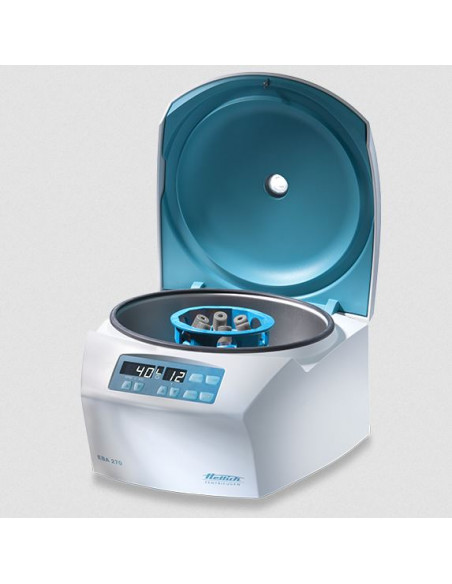Centrifuge Hettich EBA 270
The Hettich EBA 270 is a compact centrifuge with swing-out rotor, specially designed for medical practices. With a maximum speed of 4,000 rpm and an RCF of 2254, it is perfectly suited for centrifugation of conventional laboratory tubes with a capacity of 15 ml. The 90° rotating rotor enables precise separation of samples with separating gel. With its compact size and easy handling, the Hettich EBA 270 is the perfect choice for medical practices that require powerful and reliable centrifugation.

GPSR - General Product Safety Regulation
GPSR – General Product Safety Regulation
Responsible Economic Operator according to GPSR:
Andreas Hettich GmbH
Föhrenstraße 12
78532 Tuttlingen
Germany
Tel. +49 7461 7050
FAX: +49 7461 705 1125
https://www.hettichlab.com/de/kontakt/
Product Safety Sheet in Accordance with GPSR (General Product Safety Regulation) for the Hettich EBA 270 Centrifuge
1. Product Identification
- Product Name: Hettich EBA 270 Centrifuge
- Model Number: EBA 270
- Manufacturer: Andreas Hettich GmbH & Co. KG
- WEEE-Reg. No.: DE 92954423
- Application: Medical device compliant with the IVD Directive 98/79/EC, specifically designed for human in-vitro diagnostics.
2. Intended Use
The Hettich EBA 270 centrifuge is specifically designed for use in medical practices, small laboratories, and blood collection. It is used for the separation and preparation of samples, particularly blood samples with separation gels, through centrifugation.
3. Key Technical Data
- Max. Capacity: 6 x 15 ml
- Max. RCF: 2,254
- Max. Speed (RPM): 500 – 4,000 min⁻¹ (adjustable in increments of 100)
- Weight: approx. 14 kg
- Cooling: Air cooling
- Dimensions (W x D x H): 326 x 389 x 239 mm
- Maximum Noise Level: ≤ 51 dB(A)
- Power Supply: Standard mains connection
4. Safety Information
-
General Safety Instructions:
- The device must only be operated by trained personnel.
- The device may only be used for its intended purpose.
- Read the user manual completely before first use.
- Sale is restricted to medical professionals in compliance with legal regulations.
-
Electrical Safety:
- Ensure the device is connected to a grounded power outlet.
- Only use the power supply recommended by the manufacturer.
- Disconnect the power supply before cleaning or maintaining the device.
-
Mechanical Safety:
- The rotor must be properly and symmetrically loaded.
- Verify that the rotor is securely seated before operation.
- Do not open the lid until the rotor has come to a complete stop.
- Do not exceed the maximum fill volume specified for sample tubes.
-
Operational Safety:
- Prevent liquids from entering the rotor chamber.
- Sample tubes must be evenly filled to avoid vibrations or damage.
- The centrifuge must only be operated in a clean and dry environment.
-
Overheating Protection:
- The device is equipped with overheating protection that will automatically shut it down in case of overheating.
5. Health and Environmental Risks
-
Health Risks:
- Improper use may cause injuries due to unbalanced rotors or unsecured sample tubes.
- Contact with biological samples (e.g., blood serum) may pose health risks. Always wear appropriate protective equipment (e.g., gloves, safety goggles).
-
Environmental Risks:
- The device contains electronic components. Dispose of it in accordance with applicable WEEE regulations.
6. Emergency Measures
-
In Case of Malfunction:
- Immediately turn off the device and disconnect it from the power supply.
- Inspect the rotor and rotor chamber for damage or foreign objects.
- Contact an authorized service provider.
-
In Case of Electrical Short Circuit:
- Disconnect the power supply (e.g., switch off the circuit breaker).
- Do not attempt to repair the device yourself.
7. Maintenance and Care
-
Cleaning:
- Clean the centrifuge with a soft cloth and mild detergent. Do not use aggressive chemicals.
- Regularly clean the rotor and rotor chamber of dust and residues.
-
Maintenance:
- Have the device inspected at least once a year by the manufacturer or an authorized service provider.
- Replace wear parts, such as rotors and seals, as necessary.
-
Storage:
- Store the device in a dry, dust-free environment.
8. Labels and Warnings
- Warning Symbols on the Device:
- ⚠️ Caution: Read the user manual.
- ⚡ Warning: Electrical hazard.
- ♻️ Dispose of in accordance with WEEE regulations.
9. User Responsibility
The user is responsible for:
- Adhering to the specified areas of application.
- Ensuring regular maintenance and proper handling of the device.
- Training personnel in the correct use of the device.
- Complying with applicable regulations for medical devices.
10. Declaration of Conformity
The Hettich EBA 270 Centrifuge complies with the following:
- IVD Directive 98/79/EC
- WEEE Directive 2012/19/EU
- EMC Directive 2014/30/EU
- Low Voltage Directive 2014/35/EU
11. Contact Information
- Manufacturer: Andreas Hettich GmbH & Co. KG
- Address: Föhrenstr. 12, 78532 Tuttlingen, Germany
- Phone Number: +49 7461 705-0
- Email: info@hettichlab.com
- Website: www.hettichlab.com
12. Additional Notes
This product safety sheet has been prepared in accordance with the General Product Safety Regulation (GPSR). It does not replace the manufacturer’s user manual. The device must only be used by trained medical professionals.










